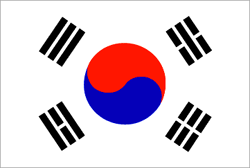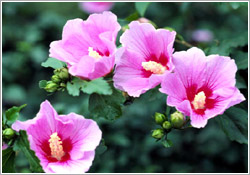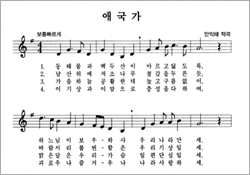Every symbols has it's own meaning and from it's own meaning, we start to know more about the country. I do remember when I'm in my Junior High. We usually memorized all the Asian countries in one of our subject. We memorized them not only the names but with also their capital and currencies names.
For this time I want you to know the National Symbols of South Korean.
 |
| Photo Credit: KTO Official Site |
The Korean Flag is called "Taekgeukgi" in Korean language.
> It's designed symbolizes the principle of Yin and Yang in oriental philosophy.
> The circle in the center of the Korean flag is divided into two
1. The upper red section represent the proactive cosmic of the yang.
2. Conversely, the blue section represent the responsive cosmic of the yin.
>The two forces together embody the concepts of continual movement, balance and harmony that characterize the sphere of infinity.
>The circle was surrounded by four trigrams, one in each corner. Each trigrams represent the four universal elements: heaven (
 |
| Photo Credit : KTO Official Site |
The National Flower of South Korea is called "Mugunhwa", the rose of sharon. Every year from July to October, a profusion of mugunhwa blossoms graces the entire country. Mugunhwa is remarkably tenacious and able to withstand both blight and insects unlike many other flowers. The flowers symbolic significance stems from the Korean word "mugung" which means "immortality". This word accurately reflects the enduring nature of the Korean culture, and the determination and perseverance of the Korean people.
In Philippines they call this as "Gumamela". And in Taiwan the word "hwa" means flower. This flower has many variety of colors. There are also single and double petals and there are small and big petals.
 |
| Photo Credit : KTO Official Site |
he National Anthem of Korea is "Aegukga", which means "Love of the Country".
In 1896, the Dongnip Sinmun (Independence News) published various versions of lyrics for this song. It is not known exactly what music they were sung to in the early days. Records show that a Western-style military band was formed during the time of the Dae-han Empire (1897-1910) and that the "Dae-han Empire Aegukga" was composed in 1902 and played at important national functions.
The original words of Aegukga appeared in written form around 1907 to inculcate allegiance to the nation and foster the spirit of independence as the country faced threats of foreign annexation. Over the years, the lyrics went through several versions until they were adopted as the national anthem in the present form in 1948.
Before the birth of the Republic in 1948, the words were often sung to the tune of the Scottish folk song, Auld Lang Syne. Maestro Ahn Eak-tay (1905-1965), then living in Spain, felt that it was inappropriate to sing this patriotic song to the tune of another country's folk song. So, he composed new music to go with the lyrics in 1935, and the Korean Provisional Government in exile adopted it as the national anthem. While Koreans outside the country sang the anthem to the new tune, those at home continued to use Auld Lang Syne until Korea was liberated in 1945.
In 1948 the government of the Republic of Korea officially adopted the new version as the national anthem and began to use it at all schools and official functions.
To know more about South Korea visit this website.
Credit Info : Korea Tourism Organization



No comments:
Post a Comment
Thank you for your comments.
I will response as soon as I can. ^_^